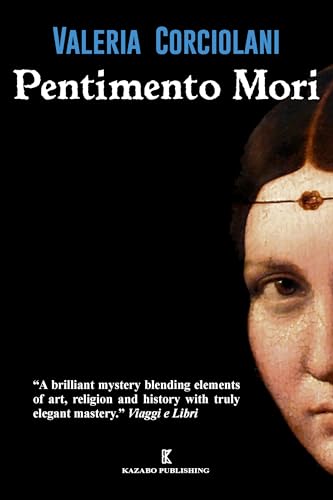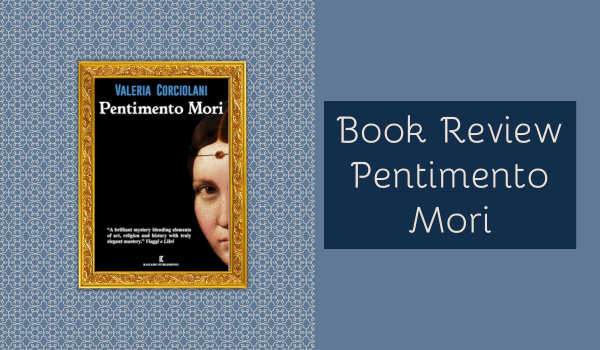Summary
Renowned art historian Dr. Edna Silvera is not your typical detective. In fact, she’s not a detective at all. But when she stumbles across an apparently impossible medieval painting in the suddenly-deceased Nando Folli’s junk shop, her curiosity lands her in trouble with the police and on the trail of a shadowy world no one wants to admit exists.
My Review
Dr. Edna Silvera is an art historian who’s been strong-armed into attending an event commemorating Dante. Reluctantly, Edna travels to the village where the celebrations are taking place and somehow ends up accidentally stumbling upon Nando Folli dead in his own antiques store with his pants down (a crucial detail that’s mentioned frequently throughout the story and seems to be of great concern to the police).
Being confronted with an unexpected dead body doesn’t seem to throw Edna off her groove at all, it actually somehow helps her focus in on something out of the ordinary – an old-looking piece of wood sticking out from one of the multiple dressers in the antiques shop. Edna grabs the piece of wood for closer inspection and notices its age, so snaps a couple of photos and returns it to where she found it. When Edna gets home later and has a closer look, she realises that the piece of art she’s found is potentially an extremely old (and valuable) piece of religious artwork. The real mystery begins here and we follow Edna, police officer Bassi, and Edna’s neighbours and friends (all of whom are as annoying as they are amusing) as they attempt to figure what this piece of artwork actually is, where it came from, and why it’s been altered. This mysterious piece of artwork is the real mystery in the story, with Folli’s murder playing a secondary storyline that’s somehow entwined.
“It’s simply a matter of yellows, figs, vans, and kites,” signs Bassi, rolling his eyes sarcastically. “Why can’t I get a nice simple gang murder or an old-fashioned serial killer?”
Chapter 47, Pentimento Mori, Valeria Corciolani
The main storyline follows Edna as she tries to figure out what this piece of artwork is and where it’s come from. The story is packed with colour symbolism, paint, history, and religious artwork. I really enjoyed learning more about each of these different things as I was reading the story. The author, Valeria Corciolani, writes very clear, easy-to-understand explanations of some fairly complex and convoluted concepts. She did a very good job of explaining the significance of colour in paintings throughout history, what that tells you when you look at the colour. I like to think I’ve absorbed this info and could happily relay it to friends and family on my next holiday.
Alongside the symbolism, Corciolani does a crash course in the history of altering pieces of religious artwork, mainly who does it and why. Again, I enjoyed the chapters and sections of the story that gave a little more detail about the history of art forgeries and stolen artwork, although I’ll admit the level of depth is potentially not for everyone as the information we’re given doesn’t necessarily help the plot progress.
The murder part of the murder mystery plays second fiddle to the mystery of the artwork, which was okay for me as I didn’t find the murder victim, Nando Folli, super sympathetic as a character. There are some brief chapters from his POV at the start of the book – before he’s murdered – and he generally gives off a slimey, creepy vibe. He’s definitely not someone you’d want to be buying artwork and antiques from. There are a couple of red herrings when it comes to who the murderer is with one potential murderer being outed about halfway through the book. I have to admit I wondered where the solving the murder plot line would go from this point but it was a good way of getting your attention back to the murder.
I’d originally thought that Pentimento Mori would be a bit of a Davinci Code situation but it felt more of a Thursday Murder Club style of mystery. Corciolani’s characters reminded me of Richard Osmond’s characters but they’re dealing with the shady and sinister world of art and forgeries. Edna is a great protagonist, she’s focused, intelligent, and witty. I enjoyed her sense of humour – and generally the dry humour that runs throughout the book. Her interactions with her family members, the police detective, and her attractive neighbour are amusing and authentic – you totally get why she could quite happily throttle her mother at times.
The supporting characters are definitely needed in this story, they’re in the same position as you when you’re reading – i.e. not art experts – so they provide Edna and the author with a way to explain the intricate and, at times, complex details surrounding the altered piece of artwork in a way that’s easy and enjoyable to read.
I really enjoyed this book, it was a fun and engaging read and I really liked the protagonist. The story taught me some fun facts and got me to think (I like having a go at trying to figure the ending out before getting there). Pentimento Mori is part of a series so I’m looking forward to continuing the story if / when the next book is published in English. This one is a 4 out of 5 stars for me ⭐⭐⭐⭐
I’d like to thank Valeria Corciolani, the author, and Chiara Giacobbe at Kazabo Publishing for providing me with a copy of the book.
Bookshop.org | Amazon | Goodreads | Storygraph


